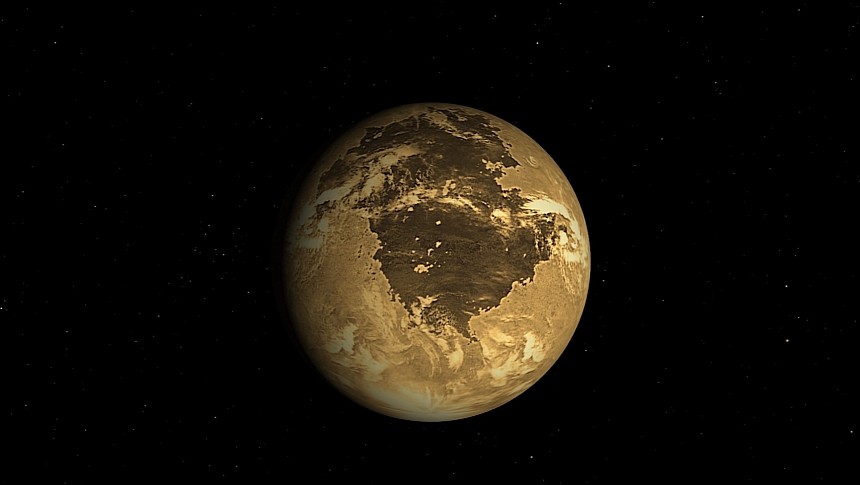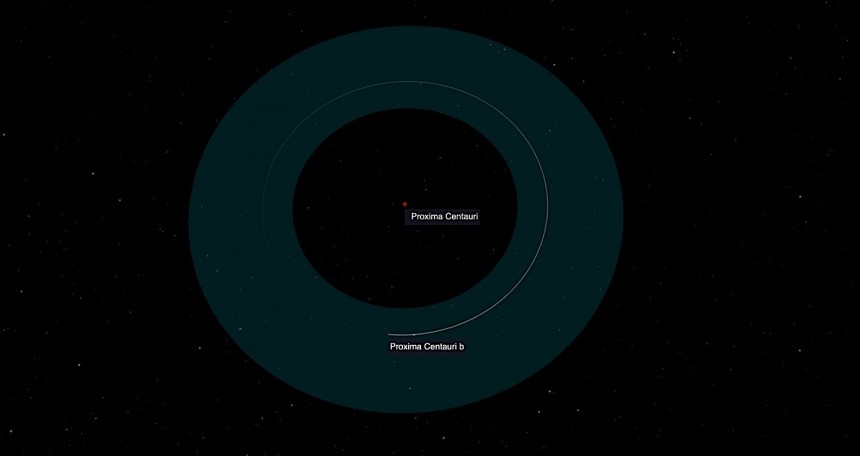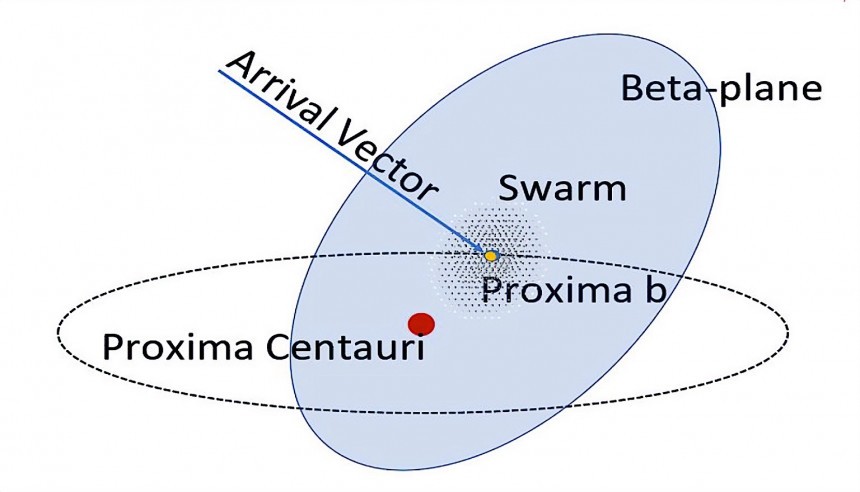Space exploration is one of the most far-reaching and creative activities humans are currently engaged in. But for all the money being spent and the efforts being made, it's a kind of activity that will take a very, very long time to achieve its ultimate goal: reach other stars.
Presently space exploration is a type of activity we humans can only perform in our immediate vicinity. Except for the two Voyager spaceships no other human-made device has ever left the solar system, putting a serious dent in people's hopes of reaching even the places that by galactic standards are right next door.
Such a place is the Proxima Centauri system. It comprises three stars, namely Proxima Centauri, Alpha Centauri A, and Alpha Centauri B, and it was recently confirmed that there are planetary systems there.
Proxima Centauri b, for instance, is an exoplanet discovered in the region in 2016. It's located just 4.2 light-years from Earth, which is an absolutely tiny distance when judged from a galactic standpoint.
When looking at it through the lens of our current technological level, Proxima Centauri b is actually generations away. Our current means of propulsion would need no less than 6,000 years to get us there, and since no one invented generational ships, that's akin to an impossibility.
So, we have a star system (with planets) that's relatively close, but no actual means of getting there ourselves, and not even the means to send an uncrewed spacecraft to take a closer look. Or do we?
At the beginning of the year American space agency NASA announced this year's Innovative Advanced Concepts (NIAC) program awards, and one of the selectees talks about sending not one, but thousands of spacecraft to Proxima Centauri b. And not only that, but these ships should be able to reach the place by the end of this century. That's during our lifetime, more or less!
The idea belongs to a guy named Thomas Eubanks from Space Initiatives. The company is a relative newcomer to the space exploration scene, but it is focusing on something no one else is doing at the moment: making tiny (positively, 50-gram-tiny) satellites.
They are called femtosatellites, and they should be capable of performing incredible tasks despite their tiny size – or should we say thanks to their tiny size, as that makes them cheap to make and launch and could lead, as per the company, to "a market in the tens of millions of dollars per year."
The main femtosatellites the company is focusing on are meant for use in low-Earth orbit, but with sufficient adaption, they could also be used to reach the alien planet we're all gunning for. In a new configuration, the devices would technically become tiny interstellar probes.
Space Initiatives proposes something that's right out of sci-fi books and movies. In a nutshell, not one, not two, but thousands of these small devices could head out into outer space to reach places never before considered possible. And it could go a bit like this.
At some point in the future, possibly even by 2100, femtosatellites will depart our planet one at a time, forming a very long string. They would then start to come together in a lens-shaped mesh of sorts that could grow to be as large as 62,000 miles (100,000 km) across.
They would do that because in themselves the probes would be useless. Their tiny size makes communication with Earth (but also observation of the target) all but impossible. When clustered together, though, they would form a very large array more than suitable for the task.
The probes would be literally powered by light, because no other means of propulsion can be devised at this scale. A very powerful laser (playing in the 100 GW class) placed here on Earth would be pointed at the probes and give them a push to relativistic speed, close enough to the speed of light to allow for nasty concepts like time dilation and length contraction to manifest themselves. It's unclear how a single laser could power thousands of these probes.
At these speeds the probe swarm would be able to reach Proxima Centauri b in years instead of thousands of years (20 as per the people behind the idea), and their dispersion over such a large area would make it almost certain at least some of them would pass close to the target, providing multiple vantage points of the planet.
The NIAC award given to this idea, officially called Coherent Picospacecraft Swarms Over Interstellar Distances, will back a simulation of the swarming techniques for these probes. If everything checks out, and we find ways of devising and using that huge laser, a mission to that distant place could begin soon.
The tech and procedures would at first have to be tested closer to home, during Earth, Moon, and possibly even Mars missions. Objects further in the solar system would follow and, ultimately, the one to Proxima Centauri b.
Space Initiatives estimates that could happen as soon as the 2070s.
Such a place is the Proxima Centauri system. It comprises three stars, namely Proxima Centauri, Alpha Centauri A, and Alpha Centauri B, and it was recently confirmed that there are planetary systems there.
Proxima Centauri b, for instance, is an exoplanet discovered in the region in 2016. It's located just 4.2 light-years from Earth, which is an absolutely tiny distance when judged from a galactic standpoint.
When looking at it through the lens of our current technological level, Proxima Centauri b is actually generations away. Our current means of propulsion would need no less than 6,000 years to get us there, and since no one invented generational ships, that's akin to an impossibility.
So, we have a star system (with planets) that's relatively close, but no actual means of getting there ourselves, and not even the means to send an uncrewed spacecraft to take a closer look. Or do we?
At the beginning of the year American space agency NASA announced this year's Innovative Advanced Concepts (NIAC) program awards, and one of the selectees talks about sending not one, but thousands of spacecraft to Proxima Centauri b. And not only that, but these ships should be able to reach the place by the end of this century. That's during our lifetime, more or less!
They are called femtosatellites, and they should be capable of performing incredible tasks despite their tiny size – or should we say thanks to their tiny size, as that makes them cheap to make and launch and could lead, as per the company, to "a market in the tens of millions of dollars per year."
The main femtosatellites the company is focusing on are meant for use in low-Earth orbit, but with sufficient adaption, they could also be used to reach the alien planet we're all gunning for. In a new configuration, the devices would technically become tiny interstellar probes.
Space Initiatives proposes something that's right out of sci-fi books and movies. In a nutshell, not one, not two, but thousands of these small devices could head out into outer space to reach places never before considered possible. And it could go a bit like this.
At some point in the future, possibly even by 2100, femtosatellites will depart our planet one at a time, forming a very long string. They would then start to come together in a lens-shaped mesh of sorts that could grow to be as large as 62,000 miles (100,000 km) across.
They would do that because in themselves the probes would be useless. Their tiny size makes communication with Earth (but also observation of the target) all but impossible. When clustered together, though, they would form a very large array more than suitable for the task.
At these speeds the probe swarm would be able to reach Proxima Centauri b in years instead of thousands of years (20 as per the people behind the idea), and their dispersion over such a large area would make it almost certain at least some of them would pass close to the target, providing multiple vantage points of the planet.
The NIAC award given to this idea, officially called Coherent Picospacecraft Swarms Over Interstellar Distances, will back a simulation of the swarming techniques for these probes. If everything checks out, and we find ways of devising and using that huge laser, a mission to that distant place could begin soon.
The tech and procedures would at first have to be tested closer to home, during Earth, Moon, and possibly even Mars missions. Objects further in the solar system would follow and, ultimately, the one to Proxima Centauri b.
Space Initiatives estimates that could happen as soon as the 2070s.








